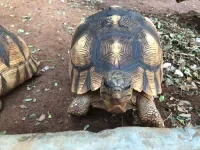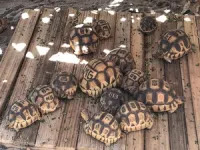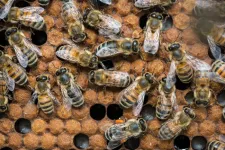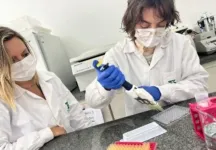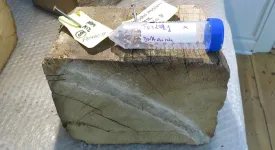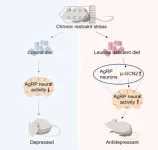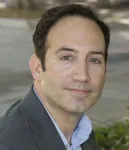(Press-News.org) Though wildlife trafficking has been effectively disrupted since the first World Wildlife Day—established 50 years ago today via the 1973 Convention on International Trade in Endangered Species (CITES) of Wild Fauna and Flora—a newly published case study on one of the world’s rarest tortoise species, the ploughshare tortoise, highlights how much room for improvement still exists.
In a new paper published in the Proceedings of the National Academies of the Sciences, University of Maryland Associate Professor Meredith Gore and her coauthors—Babson College’s Emily Griffin, Bistra Dilkina and Aaron Ferber from the University of Southern California, Michigan State University’s Stanley E. Griffis, the University of Alabama’s Burcu B. Keskin, and John Macdonald from Colorado State University—detail a 2018 effort to map ploughshare tortoises’ location within and around Soalala, Madagascar; nearby villages; known trafficking pathways and transit routes; and the amount of trafficking risk associated with each of those areas. The group of approximately 50 stakeholders also shared more qualitative information that might play a role in poachers’ trafficking process, such as paths of cultural and spiritual significance, tides’ influence on decision-making; and where poachers met to plan their activities.
This information was drawn onto a clear, plastic sheet that was laid across a color-based map of the region. That information was then digitized into a geographic information system, creating what the researchers’ called a “mess” that nevertheless revealed novel information for the effective targeting of those ploughshare tortoise trafficking networks.
“Our science team used a cross-disciplinary and cross-sectoral approach to think about, measure, and analyze data,” explains Gore. “Not only were we able to shift the data landscape to clarify how important water routes are to the resilience of the illicit supply chain, we were able to normalize technical spatial data with insights from traditionally marginalized voices—women.”
Gore and her co-authors argue that if a process like this were to be paired with the latest advancements in computational science, operations engineering, and supply chain management, together, researchers could dramatically disrupt wildlife trafficking networks, and thereby conserve more animals, like the ploughshare tortoise, who are already on the brink of extinction.
"As we celebrate World Wildlife Day, our recent work highlights the urgent need for interdisciplinary collaboration to address the complex global issue of wildlife trafficking," says Bistra Dilkina, an associate professor of computer science and industrial and systems engineering at the University of Southern California. "I feel privileged to have the opportunity to work with a trans-disciplinary team to synthesize a roadmap of how our different disciplines can work together to fight illegal wildlife trafficking and trade. In particular, I am excited to think deeply about the advantages that data-driven approaches in machine learning and optimization can bring to this important endeavor."
Looking to the future, the researchers believe that with increased interdisciplinary collaborations, conservationists may one day be able to predict which path a trafficker will take, target areas where locals could undergo trainings and be empowered to play a part in preventing wildlife trafficking, better allocate limited resources to have the greatest interventional impact, and more.
“It's easy to reflect on the array of conservation accomplishments that have been made since World Wildlife Day was first celebrated,” says Gore. “Our hope is that interdisciplinary science will produce additional high-return investments for the conservation sector in the future, most notably by advancing knowledge about changes and shifts in patterns of wildlife trafficking networks in a changing environment.”
To read the researchers’ full paper, visit doi.org/10.1073/pnas.2208268120.
To learn more about World Wildlife Day, visit wildlifeday.org/en.
END
Case study of rare, endangered tortoise highlights conservation priorities for present, future World Wildlife Days
Researchers share ploughshare tortoise case study to show how wildlife trafficking networks could be better disrupted
2023-03-03
ELSE PRESS RELEASES FROM THIS DATE:
Fluorescent protein sheds light on bee brains
2023-03-03
An international team of bee researchers involving Heinrich Heine University Düsseldorf (HHU) has integrated a calcium sensor into honey bees to enable the study of neural information processing including response to odours. This also provides insights into how social behaviour is located in the brain, as the researchers now report in the scientific journal PLOS Biology.
Insects are important so-called model organisms for research. Despite more than 600 million years of independent evolution, insects share more than 60% of their DNA with humans. For several decades it was mainly the fruit fly ...
Researchers identify gene mutation capable of regulating pain
2023-03-03
Pain afflicts at least 1.5 billion people worldwide, and despite the availability of various painkilling drugs, not all forms of pain are treatable. Moreover, pain medications can have side-effects such as dependence and tolerance, especially in the case of morphine and other opioids.
In search of novel painkillers, researchers at Butantan Institute’s Special Pain and Signaling Laboratory (LEDS) in São Paulo, Brazil, studied TRPV1, a sensory neuron receptor that captures noxious stimuli, including heat and the burning sensation conveyed by chili peppers, and ...
Chemotherapy-resistant ovarian cancer cells protect their neighbors
2023-03-03
Certain chemotherapy-resistant ovarian cancer cells protect neighboring cancer cells by sending signals that induce resistance, according to a new study from University of Pittsburgh and UPMC researchers that may help explain why ovarian cancer patients respond poorly to chemotherapy or relapse after treatment.
Published in Clinical Cancer Research, the study investigated chemotherapy-resistant cancer cells called quiescent cells. As chemotherapy primarily targets rapidly dividing cells, quiescent cells are resistant because they divide ...
When ‘good genes’ go bad: how sexual conflict can cause population collapse
2023-03-03
Males of a species evolving traits for sexual conflict can cause problems for females, and, ultimately, the whole population.
A new model by Imperial College London and University of Lausanne researchers, published in Proceedings of the National Academy of Sciences, shows how so-called ‘good genes’ can sometimes cause a population to collapse.
Males of any species may compete for females, either by fighting other males for access or impressing females to win their approval. In both cases, ...
UC Davis study uncovers age-related brain differences in autistic individuals
2023-03-03
A new study led by UC Davis MIND Institute researchers confirms that brain development in people with autism differs from those with typical neurodevelopment. According to the study published in PNAS, these differences are linked to genes involved in inflammation, immunity response and neural transmissions. They begin in childhood and evolve across the lifespan.
About one in 44 children in the U.S. has autism. Autistic individuals may behave, communicate and learn in ways that are different from neurotypical people. As they age, they often have challenges with social communication ...
An interdisciplinary solution for enhanced high-resolution imaging in electron and optical microscopy
2023-03-03
Although electron microscopy can already reveal details as small as one nanometer, ongoing research seeks to break through barriers limiting image quality and reducing the optical dose on the samples. Aberration is a common problem in electron microscopy that can reduce the resolution and quality of the images produced. Additional complex phase and amplitude controls are needed in these microscopes. An international team of researchers led by Akhil Kallepalli (Kallepalli Lab) working within the Optics Group at the University of Glasgow set out to address the problem. Working from an optics perspective, they developed and tested a new ghost ...
Tree rings and strontium point researchers to the provenance of 400-year-old timber
2023-03-03
Tree-ring analysis – so-called dendrochronological analysis – has been part of archaeology for many years and has made it possible for archaeologists to date old wooden objects with great precision. And in many cases, they have also been able to determine the provenance of the wood.
But it has proven difficult for researchers to determine timber’s place of origin when the historic timber was imported into Denmark from further afield to serve as building material.
In a new study in the journal PLOS ONE, Associate Professor Aoife Daly and Dr Alicia Van Ham-Meert from the University of Copenhagen show that combining analyses of ...
Chinese scientists discovered roles of hypothalamic amino acid sensing in antidepressant effects
2023-03-03
Depression is a leading cause of disability around the world and contributes greatly to the global burden of disease. Nutrition is essential for the maintenance of normal emotional states. Nutritional therapy is rising up in many disease treatments, but little is known in the depression field. Unbalanced nutrition is implicated in the etiology of depression, potentially hindering treatment. For example, many essential amino acids (EAAs) in serum are changed in patients with depression, such as tryptophan, threonine, leucine, isoleucine, and valine. However, whether EAA contributes to depression ...
Health policy experts call for confronting anti-vaccine activism with life-saving counter narratives
2023-03-03
Public and private sector health officials and public policymakers should team up immediately with community leaders to more effectively disseminate accurate narratives regarding the life-saving benefits of vaccines to counter widespread, harmful misinformation from anti-vaccine activists.
Such is the message of a UC Riverside-led viewpoint piece published Thursday, March 2, in the leading international medical journal, The Lancet.
“We need to consistently amplify the best science and find the best ways of communicating so that people are hearing it through multiple channels instead of through one or two sources,” ...
Inspirational women from UK Synchrotron launch major recruitment campaign to promote STEM careers at AAAS international science conference
2023-03-03
Today, at the prestigious AAAS science conference in Washington DC, Diamond Light Source, the UK’s synchrotron science facility, will unveil plans for its biggest recruitment campaign since its inception 20 years ago. Dozens of new roles will be available in the coming year and some examples of the variety of STEM careers will be showcased and celebrated by an all-women line up from the Diamond team. This recruitment drive aims to ensure the facility has the knowledge and expertise required to help plan and deliver world leading science for the next decade and beyond
In the lead up to ...
LAST 30 PRESS RELEASES:
SwRI upgrades nuclear magnetic resonance laboratory for pharmaceutical R&D
House sparrows in northern Norway can help us save other endangered animals
Crohn's & Colitis Foundation survey reveals more than 1/3 of young adults with IBD face step therapy insurance barriers
Tethered UAV autonomous knotting on environmental structures for transport
Decentralized social media platforms unlock authentic consumer feedback
American Pediatric Society announces Vanderbilt University School of Medicine as host institution for APS Howland Visiting Professor Program
Scientists discover first method to safely back up quantum information
A role for orange pigments in birds and human redheads
Pathways to net-zero greenhouse gas emissions for Southeast Asia
A JBNU–KIMS collaborative study on a cost-effective alloy matches superalloys for power plants and energy infrastructure
New study overturns long-held model of how plants coordinate immune responses.
New AI model predicts disease risk while you sleep
Scientists discover molecular ‘reshuffle’ and crack an 80-year-old conundrum
How stressors during pregnancy impact the developing fetal brain
Electrons lag behind the nucleus
From fungi to brain cells: one scientist's winding path reveals how epigenomics shapes neural destiny
Schizophrenia and osteoporosis share 195 genetic loci, highlighting unexpected biological bridges between brain and bone
Schizophrenia-linked genetic variant renders key brain receptor completely unresponsive to both natural and therapeutic compounds
Innovative review reveals overlooked complexity in cellular energy sensor's dual roles in Alzheimer's disease
Autism research reframed: Why heterogeneity is the data, not the noise
Brazil's genetic treasure trove: supercentenarians reveal secrets of extreme human longevity
The (metabolic) cost of life
CFRI special issue call for papers: New Frontiers in Sustainable Finance
HKU Engineering scholar demonstrates the smallest all-printed infrared photodetectors to date
Precision empowerment for brain "eavesdropping": CAS team develops triple-electrode integrated functional electrode for simultaneous monitoring of neural signals and chemical transmitters during sleep
Single-capillary endothelial dysfunction resolved by optoacoustic mesoscopy
HKU three research projects named among ‘Top 10 Innovation & Technology News in Hong Kong 2025’ showcasing excellence in research and technology transfer
NLRSeek: A reannotation-based pipeline for mining missing NLR genes in sequenced genomes
A strand and whole genome duplication–aware collinear gene identification tool
Light storage in light cages: A revolutionary approach to on-chip quantum memories
[Press-News.org] Case study of rare, endangered tortoise highlights conservation priorities for present, future World Wildlife DaysResearchers share ploughshare tortoise case study to show how wildlife trafficking networks could be better disrupted
